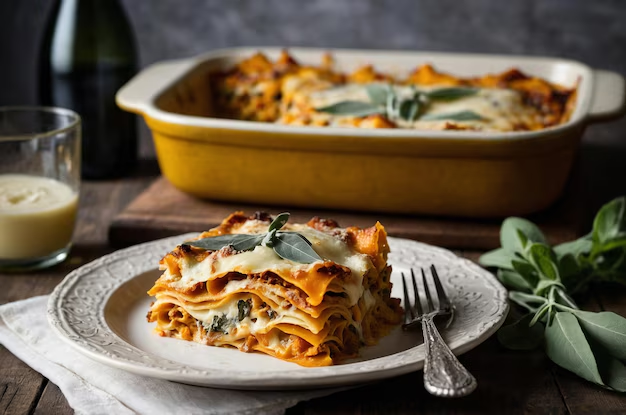Perfecting the Art of Lasagna: How Long to Cook a Lasagna from the Refrigerator?
Lasagna, a beloved classic in the culinary world, offers a comforting blend of flavors and textures. But what happens when you've assembled a beautiful lasagna and left it in the fridge for later? Knowing how to cook a refrigerated lasagna properly is key to preserving its rich tastes and textures. While this might seem like a simple task, timing and technique make all the difference. Let's dive deeper into this topic and unlock the secrets to perfecting your lasagna from the refrigerator.
The Significance of Cooking Time
Cooking a lasagna that's been refrigerated involves more than just heating it up. Ensuring that each layer—from noodles to sauce and cheese—is perfectly cooked is a small culinary art. A couple of factors influence the cooking time:
- Size and Thickness of Lasagna: Thick layers and a larger size will naturally need more time to cook thoroughly.
- Container Material: Glass and ceramic hold heat differently from metal, affecting cook time.
- Initial Temperature: A lasagna that spent less time in the refrigerator will differ in cooking time compared to one that's been sitting overnight.
A critical goal is to avoid undercooking or overbaking, ensuring each bite is just right.
Steps to Cook Refrigerated Lasagna
Here's a straightforward guide to cooking lasagna that has been chilling in your fridge:
Preheat and Prepare
1. Preheat Your Oven: Set your oven to 375°F (190°C). This temperature is generally ideal for ensuring even heating throughout the lasagna.
2. Prepare the Lasagna: If desired, sprinkle a bit of extra cheese on top before baking to add that irresistible gooey finish.
Cooking
3. Cover and Cook:
- Cover the Lasagna with aluminum foil. This step prevents the top layer from drying out while allowing the middle to heat thoroughly.
- Bake for 20-25 minutes with the foil on. This period allows the internal temperature to rise gradually.
4. Remove the Foil:
- Continue to Bake for an Additional 25-30 minutes. Removing the foil lets the top layer become golden and bubbly, creating that signature lasagna crust.
Resting
5. Rest Before Serving:
- Let the lasagna rest for about 10 minutes before serving. This rest period ensures the layers set and maintain their shape, giving a perfect slice every time.
Visual Cues to Ensure It's Ready
As you cook, you should look for the following cues to confirm your lasagna is perfectly heated:
- Bubbling Corners: If you see bubbles along the edges, it's a good sign that the center has heated through.
- Golden Top: The top should have a delicious golden hue with some small burnt cheese patches.
- Internal Temperature: Use a meat thermometer if available. An internal temperature of at least 165°F (74°C) in the center indicates it's ready to enjoy.
Common Challenges and Solutions
Cooking a lasagna from the refrigerator doesn't guarantee a smooth sailing every time. Here are some common issues and ways to handle them:
Uneven Heating
Solution: Rotate your dish halfway through the cooking process to ensure even heating. Ovens can have hot spots, and a simple turn can make a difference.
Dry Top Layer
Solution: If your top is drying out too quickly, add a splash of sauce or a light layer of cheese halfway through to retain moisture.
Soggy Center
Solution: Ensure you drain sauces and ingredients well before layering. Excess moisture can lead to a soggy dish.
Related Tips for Perfect Lasagna
Storage and Shelf Life
Understanding how to store lasagna effectively plays into how it cooks from the refrigerator. Here’s how to ensure it stays fresh:
- Airtight Containers: Keep lasagna in a well-sealed container to prevent it from absorbing other fridge odors and maintain freshness.
- Use Within 3 Days: For the best flavor and texture, try to consume or cook your refrigerated lasagna within three days.
Freezing Lasagna
If you're planning longer storage, freezing could be a better option:
- Assemble But Don't Bake: When freezing, it's wise to assemble the lasagna but hold off on baking.
- Proper Packaging Is Key: Wrapping properly in plastic wrap and foil prevents freezer burn.
Reheating Tips
When reheating leftovers, maintain moist and flavorful lasagna with these approaches:
- Add Moisture: Sprinkling some water or sauce before reheating can prevent drying out.
- Microwave vs. Oven: For quick reheats, a microwave works fine, but for a standard oven, a lower temperature can help maintain the dish's integrity.
A Handy Summary 👇
Here's a quick at-a-glance guide to cooking and handling your refrigerated lasagna:
- 🔧 Preheat to 375°F (190°C)
- 🔒 Cover to retain moisture
- ⏱ Cook for 20-25 mins with foil, then 25-30 mins without
- ⏲ Rest for 10 mins before serving
- 🌡 Always aim for an internal temperature of 165°F
- 🗓 Use within 3 days for best freshness
- ❄️ Consider freezing for longer storage, and reheating stays moist with a sprinkle of water or sauce
Conclusion
Cooking a perfect lasagna from the refrigerator calls for a balance of timing, temperature, and technique. Understanding the nuances of your equipment and ingredients will turn what could be a rushed just-heat-it-up task into a culinary practice that respects this dish's flavorful layers. Whether you're preparing a quick family dinner or planning for required leftovers, these insights ensure each bite is mouthwateringly delicious. 🍽️
